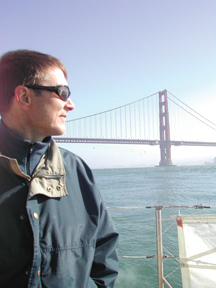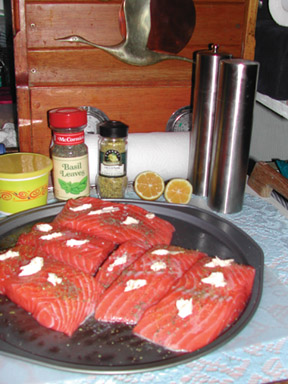Cooking at sea is a special challenge. First, a provisional plan has to be made that will not activate any allergies, yet be appetizing to the crew.

Published: February, 2005
Cooking at sea is a special challenge. First, a provisional plan has to be made that will not activate any allergies, yet be appetizing to the crew. Sometimes crews at sea lose their interest in food and without food lose their energy to function well. Sailing is the main focus but the food can be a highlight, particularly the dinner meal at the start of the rotating watch schedule (three hours on watch and three hours sleeping through the night).
The food selected for these special meals needs to be nutritionally balanced, easy to prepare, and tasty, but not so heavy that the diner becomes sleepy on his watch. Food often has to be repackaged for stowing aboard to ensure that it is divided into adequate portions, sealed properly so it won’t spoil, and wrapped well to keep it fresh and dry. Planning meals with fresh or frozen food is carefully orchestrated because of limited dry storage and refrigeration.
It is a challenge to cook a fine meal afloat, especially when wedged or braced into the small U-shaped galley. Cooking activities are timed to the roll of the sea and the rhythm of watches when people are awake and on duty. The galley stove, when set free, swings on pins to the movement of the boat, which is called being gimbaled. Gimbaling can make stirring a sauce easy if the waves are timed right. Having the side counter gimbaled also makes it easier to produce a good meal in rough seas; things needed will not roll out of reach. This trip was carefully planned so that it took place during a three-day window between storms toward the end of January. The crew welcomed a smooth ride to get the boat down the coast toward Mexico for several weeks of skippered charters before it heads home in early May. The chef was new sailor Wayne Branscombe, cooking with an Afterguard recipe.
Salmon Afloat for a crew of 5 (The whole meal takes 20 minutes to prepare.)
Start the side courses first. When the fish is started, it cooks very fast. We paired the Salmon Afloat with a wild rice mixed with herbs, bits of mushroom, and sherry sautéed sweet onion, adding the onion to the rice when it was done.
First, sauté the onion in a frying pan and set aside while the water boils and the rice starts. Wipe out the pan and use the same pan for the salmon. Add a splash of Canola oil. Canola does not burn like olive oil. If you prefer the taste of olive oil, use 10 percent olive oil and 90 percent Canola.
Start the broiler. Ovens can take about 10 minutes to heat at sea. It needs to be very hot. Fresh fish smells light and fresh. Place all of the salmon on a platter and salt it lightly on one side. Let it sit for 10 minutes. Blot moisture off the salmon drawn up by the salt. If poaching, place the filets in milk for a 10-minute soak, then blot. For broiling, the salt helps crisp the surface for a tasty result.
After blotting, sprinkle the fish with the listed seasonings to taste. Reserve the lemon for a garnish when serving so each can choose how much to use. There will still be salt on the fish, so it is not necessary to sprinkle salt on the fish after blotting off the moisture. Dot the fish with bits of butter. Heat a frying pan to medium high. Place the fish backside down to sear the bottom. It takes about 3 minutes for the fish to cook 1/3 of the way to turn the seared portion of the meat to a milky pink.
Place the seared fish on a hot broiler pan, but don’t crowd fillets. It is better to broil a few at a time rather than lower the oven temperature. At home this might not be an issue, but on a boat the hot broiler can cool too much to achieve the desired result.
After approximately 5 minutes, the top of the salmon fillet will be lightly browned from the butter. When serving, place on top of the rice. To accent the flavors, serve a Caper Tartar Sauce with a slice of Meyer Lemon. If cooking in shifts, place back on the tray and loosely tent till all are cooked.
Our chef was Wayne Branscombe, who had answered an e-mail for an adventure afloat traveling south by sail. Wayne wanted to find out what sailing life was all about. After being a national champion recreational sky diver all over the northern continent for 20 years, he was looking for a new sport and challenge. Wayne helped Chuck during the last three weeks of preparation before leaving Vancouver on New Year’s Day. He learned to sail as they slipped off the dock lines. Wayne is a network analyst who primarily contracts to energy companies in Calgary and Edmonton. Reflecting on the two sports, he said they are much alike. They both have lots of training and preparation for short periods of excitement. Obviously, the time spent sailing is a lot longer than dropping from a plane. Wayne was happy to learn about cooking afloat as it might come in handy as he works his way to Costa Rica and other points south by sailboat. At the end of the day, there just aren’t many views that can compare to those of the sea.
In the three days at sea, there were many sights to enjoy. Off the coast of Monterey, the fog created a light wind to sail by and the sun peaking through the fog created a monochromatic daytime sea and soft sunset views. South of Big Sur; a Dahl dolphin pod played off the bow and around the boat for 20 minutes as the pod of nearly 200 leaping playful creatures passed by, heading out to sea. Vessels were few, but a sailboat from Alameda named Bright Star passed close by to say hello over the radio in the night. They were full of news of a light breeze ahead in the Santa Barbara Channel where the engine could be turned off and it was possible to sail in clear and warmer air. In the morning near Pt. Conception, a pod of Pilot Whales played near but not too close to the boat, resurfacing for a few minutes, then disappearing for a half an hour playing peek-a-boo for several hours. In the afternoon, Steve and Captain Chuck pulled out guitars and played a concert as they continued up the channel. At sunset in the Santa Barbara Channel, even the light wind died down which left a nearly glassy sea with a golden highway pointing where the sun was setting. As the full moon rose, it shined a trail-like silver highway, leading the boat to its destination. Upon approaching the harbor, the crew on the bow stood at attention watching for crab traps, a constant concern when sailing in less than 100 fathoms ( 600 feet deep). In the morning, Santa Barbara showed itself to be a very pretty town to make landfall.
If interested in joining Chuck and Laila in the Sea of Cortez for a week or weekend this spring, contact Afterguard Sailing Academy at (510) 333-1121.



